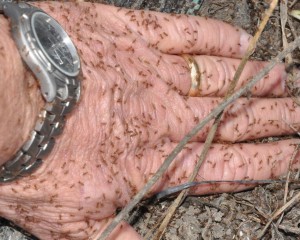“We can’t live them; we can’t live without them!” This is probably one of the most appropriate quotes when applied to ants.
This year I live on the 1st floor of Martel, which basically means that my “unofficial” roommates are from the class Insecta. I have seen my fair share of spiders, dandy long legs, and cockroaches! Well, recently, I have come across the infamous ants! I was enjoying a nice shower after a long, cold day at school, when, all of a sudden, a line of ants appeared on my shower wall! Being the irrational coward that I am, I freaked out and ran straight out of the bathroom! Luckily, I didn’t see the ants for a few weeks, but now the ants started reappearing out of nowhere! UGH!
The little black ants that you see around campus are most likely Monomorium minimum. They are rather harmless and play a huge role in our ecosystem. They are scavengers that feed on bird droppings, dead insects, and leftover food. Unfortunately, those aren’t the only insects that inhabit Houston. In fact, there has been an increase in the diversity of ants in Houston! Particularly, a new invasive species you may know as the “tawny crazy ant” or formerly the “Rasberry crazy ant”, have made its way to Texas, Florida, Louisiana, and Mississippi! It’s rapidly spreading across the southern region of the United States.

Photos taken by the Joe A. MacGown/Mississippi Entomological Museum
The “tawny crazy ant” is originally from South America, specifically Argentina and southern Brazil. Due to the increase in trading with South America, a few of these tawny crazy ants were able to get into America. The scientifically accepted name of the “tawny crazy ant” is Nylanderia fulva and it is known to be the most aggressive invasive species in the world! (You really don’t want to mess around with them) From electrical wires to livestock, they have a niche for everything. The “tawny crazy ants” damage electrical equipment by forming bridges between the electrical currents, which in turn, causes it to short out. One good thing about Nylanderia fulva is that they don’t sting.
The “tawny crazy ant” is successful for multiple reasons. Firstly, they are highly competitive and adaptive. They can easily turn foreign land into their home. UT researchers studied the invasion of tawny crazy ants in a fire ant dominated location and saw that the tawny ants were able to completely eliminate the fire ants in that region.
Furthermore, it has been suggested that they have secrete a very potent chemical for defense and offense. Like other ant species, Nylanderia fulva produces formic acid in their poison glands, but they produce more than two orders of magnitude of formic acid compared to other species. Thus, they can easily kill off other species in the same area, making them a very strong competitor.
Clearly, this is an issue because the tawny crazy ants are rapidly reducing the diversity and abundance of insects. In addition, it is very difficult to get rid of these pests! The tawny crazy ants do not readily ingest the poison bait that we often use to control fire ant mounds. They also don’t form the same type of colonies as other ants, making it difficult to kill a population. They take up a large amount of space and they are not particularly organized; they spread out randomly and have loose trails.
In short, we find ways to stop this invasive species from spreading becaues they are not only harming us, but they are also harming our fellow Earth residents!
Check out this video showing the aggressive behavior of the tawny crazy ants!!


